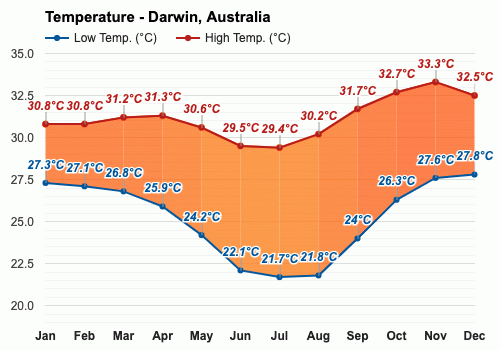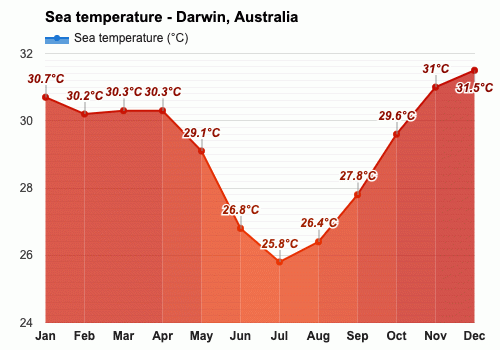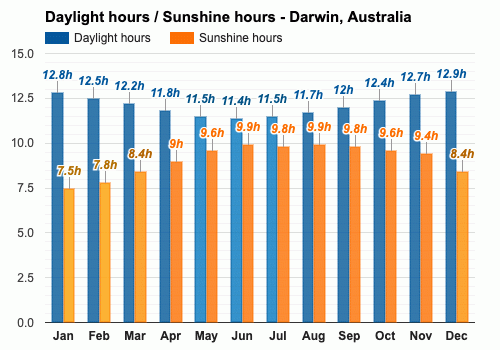Contents
- The climate of Darwin
- The best time to visit Darwin
- The worst time to visit Darwin
- Spring weather in Darwin
- Summer weather in Darwin
- Autumn weather in Darwin
- Winter weather in Darwin
- Weather in January
- Weather in February
- Weather in March
- Weather in April
- Weather in May
- Weather in June
- Weather in July
- Weather in August
- Weather in September
- Weather in October
- Weather in November
- Weather in December
- Frequently asked questions
- Average temperature
- Average pressure
- Average wind speed
- Average humidity
- Average rainfall
- Average rainfall days
- Average sea temperature
- Average daylight
- Average sunshine
- Average sunshine days
- Average UV index
- Average cloud cover
- Average visibility
The climate of Darwin
With its tropical nature, rainfall in Darwin has a marked seasonal pattern. December to March are the wettest months with rainfall exceeding 200mm (7.87") and reaching 340mm (13.39") in January. Contrarily, the months from May to August almost lack any significant rainfall, with June and July experiencing just 2mm (0.08") rainfall. In respect of cloudy days, the early part of the year, between January and March, has a higher proportion, close to 47%, while the rest of the year witnesses fewer clouds in the sky.
In terms of sunshine, Darwin basks under the sun between 7.5 to 9.9 hours every day, with the maximum amount of sun being observed from May to September. Interestingly, the sea temperatures range from 25.8°C (78.4°F) to 31.5°C (88.7°F) all through the year, adding a soothing rhythm to the regional climate.
The best time to visit Darwin
Additionally, this is the period with the least rainfall; May to July just witnesses a 2mm (0.08") fall. The sea temperatures, varying from 26.4°C (79.5°F) to 29.1°C (84.4°F), make sea activities such as swimming or snorkelling quite enjoyable during these months. With a mere cloud presence of 9% to 20%, clear blue skies can be expected during this period.
The worst time to visit Darwin
Despite these less desirable conditions, some visitors might find charm in the region's lush greenery during this time, while keeping in mind the substantial rainfall and humid weather.
Spring weather in Darwin
Summer weather in Darwin
Autumn weather in Darwin
Winter weather in Darwin
Weather in January
Weather in February
Weather in March
Weather in April
Weather in May
Weather in June
Weather in July
Weather in August
Weather in September
Weather in October
Weather in November
Weather in December
Frequently asked questions
What is the most humid month in Darwin?
What is the wettest month in Darwin?
How much does it rain in Darwin?
What is the month with the least sunshine in Darwin?
When is the lowest UV index in Darwin?
What is the least humid month in Darwin?
What is the driest month in Darwin?
What is the month with the shortest days in Darwin?
What is the month with the most sunshine in Darwin?
What are the coldest months in Darwin?
What month is the sea coldest in Darwin?
What is the warmest month in Darwin?
What is the month with the highest UV index in Darwin?
When is the sea warmest in Darwin?
When are the longest days in Darwin?
Is there Daylight Saving Time (DST) in Darwin?
Average temperature
Darwin, Australia

The warmest month (with the highest average high temperature) is November (33.3°C).
The month with the lowest average high temperature is July (29.4°C).
The month with the highest average low temperature is December (27.8°C).
The coldest month (with the lowest average low temperature) is July (21.7°C).
Average pressure
Darwin, Australia

- Average pressure in January:
1006.3mbar - Average pressure in February:
1007.2mbar - Average pressure in March:
1008mbar - Average pressure in April:
1010mbar - Average pressure in May:
1011.7mbar - Average pressure in June:
1013mbar
- Average pressure in July:
1013.2mbar - Average pressure in August:
1013.2mbar - Average pressure in September:
1012.2mbar - Average pressure in October:
1010.8mbar - Average pressure in November:
1008.8mbar - Average pressure in December:
1007mbar
The months with the highest atmospheric pressure are July and August (1013.2mbar).
The month with the lowest atmospheric pressure is January (1006.3mbar).
Average wind speed
Darwin, Australia

- Average wind speed in January:
15.3km/h - Average wind speed in February:
14.2km/h - Average wind speed in March:
11.4km/h - Average wind speed in April:
10.9km/h - Average wind speed in May:
14.2km/h - Average wind speed in June:
14.5km/h
- Average wind speed in July:
13.1km/h - Average wind speed in August:
11.2km/h - Average wind speed in September:
9.9km/h - Average wind speed in October:
10.3km/h - Average wind speed in November:
10km/h - Average wind speed in December:
11.3km/h
The windiest month (with the highest average wind speed) is January (15.3km/h).
The calmest month (with the lowest average wind speed) is September (9.9km/h).
Average humidity
Darwin, Australia

The months with the highest relative humidity are January and February (78%).
The month with the lowest relative humidity is June (57%).
Average rainfall
Darwin, Australia

- Average rainfall in January:
340mm - Average rainfall in February:
225mm - Average rainfall in March:
219mm - Average rainfall in April:
105mm - Average rainfall in May:
25mm - Average rainfall in June:
2mm
The wettest month (with the highest rainfall) is January (340mm).
The driest months (with the least rainfall) are June, July and August (2mm).
Average rainfall days
Darwin, Australia

- Average rainfall days in January:
28.3 days - Average rainfall days in February:
25.8 days - Average rainfall days in March:
27.8 days - Average rainfall days in April:
20.7 days - Average rainfall days in May:
10.1 days - Average rainfall days in June:
1.9 days
- Average rainfall days in July:
2.3 days - Average rainfall days in August:
2.3 days - Average rainfall days in September:
7.4 days - Average rainfall days in October:
14.6 days - Average rainfall days in November:
22.9 days - Average rainfall days in December:
27.7 days
The month with the highest number of rainy days is January (28.3 days).
The month with the least rainy days is June (1.9 days).
Average sea temperature
Darwin, Australia

The best month for swimming (with the highest average sea temperature) is December (31.5°C).
The coldest month (with the lowest average sea temperature) is July (25.8°C).
Average daylight / Average sunshine
Darwin, Australia

- Average daylight in January:
12h and 5min - Average daylight in February:
12h and 3min - Average daylight in March:
12h and 1min - Average daylight in April:
11h and 5min - Average daylight in May:
11h and 3min - Average daylight in June:
11h and 2min
- Average daylight in July:
11h and 3min - Average daylight in August:
11h and 4min - Average daylight in September:
12h and 0min - Average daylight in October:
12h and 2min - Average daylight in November:
12h and 4min - Average daylight in December:
12h and 5min
The month with the longest days is December (Average daylight: 12h and 48min).
The month with the shortest days is June (Average daylight: 11h and 24min).
- Average sunshine in January:
7h and 3min - Average sunshine in February:
7h and 5min - Average sunshine in March:
8h and 2min - Average sunshine in April:
9h and 0min - Average sunshine in May:
9h and 4min - Average sunshine in June:
9h and 5min
- Average sunshine in July:
9h and 5min - Average sunshine in August:
9h and 5min - Average sunshine in September:
9h and 5min - Average sunshine in October:
9h and 4min - Average sunshine in November:
9h and 2min - Average sunshine in December:
8h and 2min
The months with the most sunshine are June and August (Average sunshine: 9h and 54min).
The month with the least sunshine is January (Average sunshine: 7h and 30min).
Average sunshine days
Darwin, Australia

- Average sunshine days in January:
1.4 days - Average sunshine days in February:
0.9 days - Average sunshine days in March:
1.8 days - Average sunshine days in April:
7.2 days - Average sunshine days in May:
19.2 days - Average sunshine days in June:
27.4 days
- Average sunshine days in July:
28.4 days - Average sunshine days in August:
27.9 days - Average sunshine days in September:
20.3 days - Average sunshine days in October:
13.3 days - Average sunshine days in November:
5.5 days - Average sunshine days in December:
2.3 days
The month with the most sunshine days is July (28.4 days).
The month with the least sunshine days is February (0.9 days).
Average UV index
Darwin, Australia

The month with the highest UV index is November (UV index 8).
The months with the lowest UV index are January, February, March, April, May, June, July, August, September, October and December (UV index 7).
Average cloud cover
Darwin, Australia

The month with the most cloud cover is January (Cloud cover 47).
The month with the least cloud cover is August (Cloud cover 9).
Average visibility
Darwin, Australia

The months with the highest visibility are April, May, June, July, August, September, October and November (10km).
The months with the lowest visibility are January, February, March and December (9km).
Darwin, Australia
Weather forecast for your location
2. Allow the app to use your location


